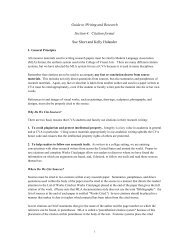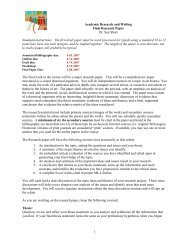Woman with a Fan: Paul Gauguin's Heavenly Vairaumati-a Parable ...
Woman with a Fan: Paul Gauguin's Heavenly Vairaumati-a Parable ...
Woman with a Fan: Paul Gauguin's Heavenly Vairaumati-a Parable ...
You also want an ePaper? Increase the reach of your titles
YUMPU automatically turns print PDFs into web optimized ePapers that Google loves.
ithe 'pet tnicitus itmpact of WesIern political, social, and sacred<br />
institutlions on contemporatr Polynesia, quoting the Bible<br />
It rottghtot.2<br />
If "l,tspiit tiodnetie 't le catholicisme" documents Gaugtin's<br />
dis(Liin lot the Catholic Church and its prelates, Ra-<br />
(notars di ralpin (A Danber's (;ossip), written by September<br />
1902, was it settling of accounts <strong>with</strong> the art world and its<br />
c ri t ics. 26 Molt' than a cdiatribe against critics, however, Racon-<br />
ais pr ovidcs an err'atic blueprint of how Gauguin thought<br />
ahout making art. Its modernity lies in its rambling structure,<br />
crafied to iesist "Beaux-Arts" codification. Similarly, his discutsivc<br />
tinitoirs Avant et apres (Before and After) were<br />
pcimcd in 1903 to persuade posterity to accord him what he<br />
peceived as his rightutl place in the history of art. 2 7 Despite<br />
the earliirt clpistolaty clash between him and the editor of the<br />
Mr) I-i tie' iance, (Gauguin entrusted the latter two manu-<br />
scripts to IFottainias. Regarding Avant et ap@r, he confided to<br />
Georgcs-l)aniel de Monfei'id, "I care about this publication<br />
becausc it's al once a vengeance and a means to make myself<br />
known ;t11l utdel-stood ... .,,28 His words were conceived to<br />
coniphcinc images that lie constructed as visual parables<br />
addressed to a t<br />
European 'lite.<br />
The Identity of the <strong>Woman</strong> <strong>with</strong> a <strong>Fan</strong><br />
lVoman <strong>with</strong> a Ian has hitierto been seen only as the beauti-<br />
ful iportrait of Tohotaua, the wife of <strong>Gauguin's</strong> friend<br />
I IaapItatnii.2'1 Shle is familiar fonmt the photograph taken by<br />
Lotis (0-elei in tlh artist's studio (Fig. 2). "' Grelet was a<br />
young Swiss traveling salesman who struck tip a friendship<br />
wi I the older tant when both were living in the Marquesas.<br />
An immaci tihotographer, be took this picture in 1902 at the<br />
bIehesi of G(auguin. Some years later, in a letter, he explains<br />
that tIhc pholograph<br />
was taken in tlhe stludio of Gauguin, several months before<br />
his dcathI. hlie wornan, who is tiarquesan and not tahitian,<br />
was posed and actually took this position on the indica-<br />
6ions of(Gauguin. We had wanted to photograph her <strong>with</strong><br />
a inude Istso. Unfortunately her breasts having already<br />
wilthered (she was baarely twenty!) obliged tis, for aesthetics,<br />
to hide thern by attaching a wrap around her neck.<br />
This xotmia wxas the wife of <strong>Gauguin's</strong> cook. She represeits<br />
Ihe )it-re minatquesan type, <strong>with</strong> this anomaly however<br />
hat she t'iiid magnificent chestnut red hair, which is something<br />
of a t arity out there. The negative of the photo has<br />
bccil dialnlagcd.C<br />
This Ittcr docnitcius that Gauguin dictated her pose from<br />
the outset, presumably before he began the painting, as<br />
Grelet tiakes no mention of it. Despite insinuations that her<br />
rclaiionshipl <strong>with</strong> (Gauguin was "intimate," the altered attire<br />
c'ctssiIatud Iby her sagging breasts implies that he had no<br />
prior physical knowledge of Ier body. Stich assumptions are<br />
more likely at product of' the enduring European fantasy<br />
abouitt the sex.lal axailability ofi non-Western women. 2 His<br />
dilapidated body, <strong>with</strong> its open sores, was hardly conducive to<br />
his playing lit'e Don Juaitt, even in a society of casual sex.<br />
Morcotxr, although Gauguin complained that access to<br />
women was limited, ite had successfully bartered for Vaeoho<br />
I) join hint in the Maisont dii Jouir in November 1901.)<br />
WOMAN WT1111 A FAA: ALlI (U GAUG IN'S HlAVENIY VAIRX\ MAT I 555<br />
Tohotaua probably remained little more than an acquaintance.<br />
The black-and-white photograph offers a glimpse of the<br />
spartan interior of <strong>Gauguin's</strong> last abode <strong>with</strong> his few worldly<br />
possessions. The room had walls of loosely woven bamboo,<br />
furnished <strong>with</strong> a plain wooden chair and a rudimentary chest<br />
of drawers, above which were tacked reproductions of art.<br />
The latter speak to <strong>Gauguin's</strong> eclectic taste: Hope by Puvis de<br />
Chavannes; Harlequin by Edgar Degas; Portrait of tlhe Artists<br />
Wl,f and Two Eldest Children by Hans Holbein; and a photograph<br />
of a.Javanese sculpture of Vishnu.ý" <strong>Gauguin's</strong> extensive<br />
use of photographs is well noted, and the artist himself<br />
wrote to Odilon Redon, "I carrv around photographs, drawings,<br />
a whole little world of comrades, who talk to me evervday."<br />
While the painted resemblance to Tohotata in her artificial<br />
position <strong>with</strong> the upright fan remains faithful to the<br />
photograph, virtually everything else has been transformed.<br />
She no longer engages the viewer directly but <strong>with</strong>draws in<br />
reverie. The coiffure of her resplendent chestnut red hait has<br />
been subdued. A white wrap, tucked above the waist as Gauguin<br />
first envisioned for the photograph, has been substituted<br />
for the floral cotton paren. She sits on a fantastic carved<br />
chair, unlike the banal angles of the actual seat. The traces of<br />
the studio are effaced from the background, and the gallery<br />
of reproductions has blurred into an organic motif sitspended<br />
in the upper left corner, below the signature, "<strong>Paul</strong><br />
Gatiguin/1902." All of these changes abstract her from the<br />
quotidian.<br />
In marked contradistinction to the picture of Tohotaua, in<br />
<strong>Gauguin's</strong> so-called portrait of his first Tahitian love (Fig. 3),<br />
Teha'amana sits primly clothed in a missionary dress, locked<br />
in an elaborate decor. The Tahitian title iroahi metna no<br />
Tehaamana ( Teha amana has many ancestors), is written on the<br />
left, not far from the signature, "P Gauguin./93" on her right<br />
knee. The sitter, wearing fragrant white frangipani and a red<br />
flower in her hair, signs of her sexual availability, looks out at<br />
the viewer. Behind her are glyphs copied from wooden tablets<br />
originating in the Easter Island and a painted frieze<br />
depicting an idol of Hina, the Tahitian goddess of the tnoon.<br />
Over each shoulder, a disembodied head floats, which<br />
may-or may not-be part of the painted background, akin<br />
to other disturbing faces found in other of <strong>Gauguin's</strong> paintings.ýs"<br />
No chair is visible, but some mangoes, at once an<br />
offering to the gods and an evocation of the apples of Eve, sit<br />
beside her.<br />
Despite the assertion of her identity in the Tahitian title,<br />
the painting is not a portrait of Teha'amana but a fiction<br />
contrived in tandem <strong>with</strong> a fabrication-Noa Voa, the artist's<br />
pseudomemoirs of his first stay in Tahiti.:'7 The absence of<br />
situating elements in <strong>Woman</strong> <strong>with</strong> a <strong>Fan</strong> retnoves the sitter<br />
from the physical density of Teha'amana's world, but her<br />
image is no less charged. Neither sitter's identity per se is<br />
relevant to the painting because <strong>Gauguin's</strong> representations of<br />
women are constructs, regardless of links real or imagined to<br />
actual individuals. Over the decade that separates these two,<br />
the synthesis of Polynesian and European references became<br />
less forced. While <strong>Gauguin's</strong> predilection fot an overt narrative<br />
recedes, images of women remain the vehicle for reflections<br />
about himself, his art, and his world.:"





